Whether you’re cooking a big holiday feast or just making a late-night batch of boxed mac and cheese, your cookware brings your grandest and humblest culinary endeavors to fruition. It’s arguably the most used equipment in your kitchen, which is why it’s important to invest in a quality set that’s durable and heats evenly.
Since 2017 we’ve researched over a hundred cookware sets and rigorously tested more than 20. The Tramontina Gourmet 12-Piece Tri-Ply Clad Cookware Set is our top pick because it offers solid construction and comfortable design at a reasonable price. If well cared for, it will last for decades. Like all of the cookware recommended in this guide, the Tramontina set works on all cooktops, including induction.
Different big-box stores may carry exclusive variations of this set—cookware manufacturers often sell variants of the same set to different retailers to avoid competition among stores, such as Target and Walmart, that sell similar items. But we tried to cut through all of that confusion by testing the best version of each cookware set that we could find across multiple retailers.
How we evaluated
- Fully clad tri-ply: We recommend only fully clad tri-ply sets, which have a layer of aluminum sandwiched between stainless steel and extended all the way to the rims.
- Strategic sizes Sets: with fewer but larger pieces let you cook more food at once (versus filler sets with smaller pieces, which can slow you down in the kitchen).
- Long-term testing: We’ve been testing various pieces of cookware from our top-pick and upgrade-pick sets for over two years (and in some cases for more than a decade).
- Real-world cooking :We sautéed chicken, made caramel, and simmered tomato sauce to test for warping, even heat distribution, and ease of handling.
Top pick
Tramontina Gourmet 12-Piece Tri-Ply Clad Cookware Set (The best cookware set)
This well-constructed, affordable, fully clad tri-ply set distributes heat evenly, and it’s durable enough to take some abuse in a busy household.

The pots and pans in the Tramontina Gourmet 12-Piece Tri-Ply Clad Cookware Set heat evenly and are a comfortable weight, so they didn’t feel as cumbersome to lift as some others we tried. We also found their rounded, ergonomically shaped handles comfortable to hold. We’re confident that this durable cookware set will last for decades.
If you are unable to find the full set or would prefer to build your own smaller set, Tramontina also sells its cookware open stock, as individual pieces. To build a great 10-piece set (which includes six pieces of cookware and four lids), here are the pieces we’d get:
- 1½- or 2-quart saucepan with a lid
- 3-quart saucepan with a lid
- 3-quart sauté pan with a lid
- a 10-inch and 12-inch skillet (the set we recommend comes with an 8-inch skillet and a 10-inch skillet, but we prefer the larger sizes since they’re more versatile)
- 8-quart stockpot with a lid
If you’d rather start with a few basics, you’ll be able to cook a lot with just a 3-quart saucepan, a 12-inch skillet, and an 8-quart stockpot. Or mix and match whatever pieces you want.
Upgrade pick
All-Clad D3 Tri-Ply Stainless Steel 10-Piece Set (A buy-it-for-life cookware set)
The pans in this top-of-the-line fully clad tri-ply set continue to impress us with their even heat distribution. Each piece of cookware is extremely durable and an ideal weight for holding.

For superior-quality cookware that lasts a lifetime, we recommend getting the All-Clad D3 Tri-Ply Stainless Steel 10-Piece Set. The pros we talked to said the All-Clad tri-ply cookware is the best for both professional and home use because it’s so durable.
In our tests, the All-Clad pans heated evenly, were comfortable to hold, and tackled every cooking job without any hiccups. Though the largest skillet measures only 10 inches instead of 12, this set can outfit your kitchen with all the other pots and pans you’re ever likely to need.
And if you’re partial to keeping your cookware bright and shiny, note that All-Clad is one of the few that looked like new when we cleaned it—even after a decade of heavy use.
Budget pick
Goldilocks Cookware Set Plus(The best budget cookware set)
This fully clad tri-ply set performed better than any other set we’ve tested under $250. We like that it includes larger skillets, but the pans are heavier and don’t have the proven longevity of our other picks.

We were impressed by the quality of the Goldilocks Cookware Set Plus, especially for its low price. Its fully clad tri-ply stainless steel heats evenly across the surface of the pans. This set also includes almost all of the pot and pan sizes we prefer, including a 12-inch skillet—a rarity in most sets.
However, unlike the All-Clad and Tramontina sets, the Goldilocks set doesn’t include a 3- or 4-quart sauté pan with a lid (though a cast-iron skillet would work in lieu of it). And some of the pieces in this set are slightly heavier than the All-Clad and Tramontina pieces.
We also experienced some minor sticking while sautéing chicken in the skillets, but it was minimal. Overall, the Goldilocks set performed better than any other set we’ve tested in this price range.
How we picked
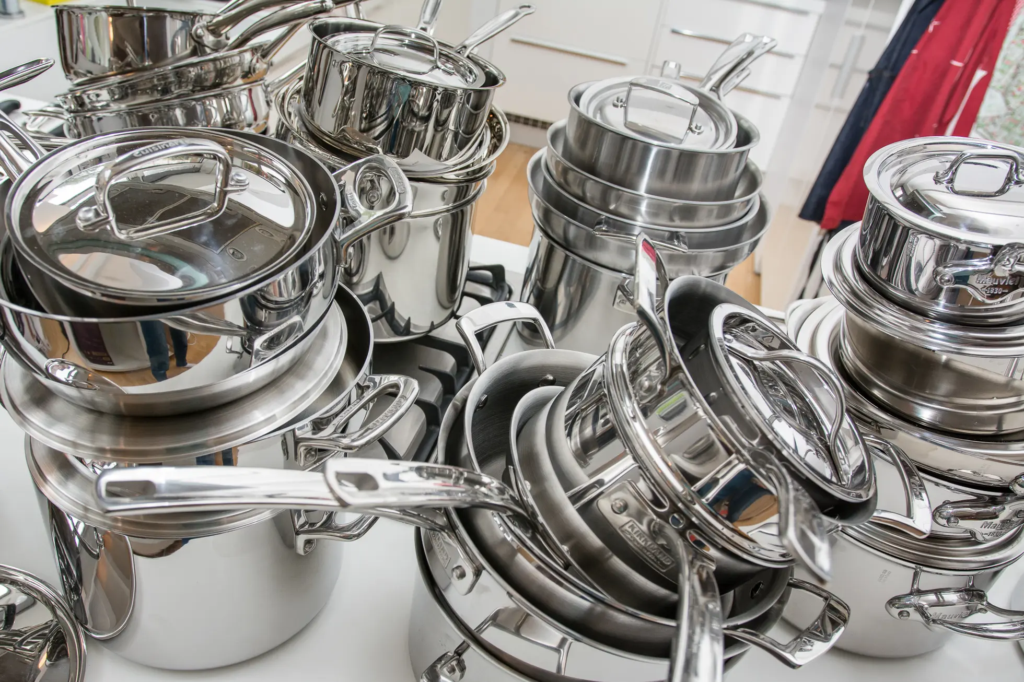
e searched for cookware that is durable and heats evenly yet is still lightweight enough to be comfortably held. Here’s a list of the most important qualities we sought when choosing which sets to test:
Durable tri-ply stainless steel: This type of cookware has an aluminum core sandwiched between layers of stainless steel. Fully clad tri-ply stainless steel is prized for its durability and even heat distribution (aluminum heats up quickly and distributes heat well; steel is very durable and holds heat nicely). It can be used at high temperatures (critical for getting a good sear on meats) and can last a lifetime.
We avoided a number of other materials: Nonstick cookware can’t be used over high heat (which degrades the coating) and eventually wears out regardless.
Aluminum and anodized aluminum aren’t induction-cooktop-compatible. Cast-iron cookware is heavy, reactive to acidic food, and more difficult to maintain—though it’s nice to have at least one versatile cast-iron skillet in your kitchen. And though copper is an excellent conductor of heat, it’s very expensive and more difficult to clean.

Optimal pot and pan sizes: To reduce the overall price of a set, most manufacturers include smaller pot and pan sizes. But smaller pan sizes require you to cook in batches and can slow you down in the kitchen. Here are the essential pot and pan sizes that an ideal set of cookware should have:
- 1½- to 2-quart saucepan with a lid: This size is for reheating a small amount of soup or melting butter.
- 3- to 4-quart saucepan with a lid: Great for making sauces or reheating stocks and soups.
- 8- and 10-inch or 10- and 12-inch skillets: Use this size for searing meats and sautéing vegetables. We prefer 10- and 12-inch skillets because they offer a larger surface area for cooking more food at once, but most manufacturers only offer 8- and 10-inch skillets in sets as a way to reduce costs.
- 3- to 4-quart skillet with a lid: It quickly reduces sauces, makes roux, and prepares shallow braises.
- 8-quart (or larger) stockpot with a lid: A big pot can boil water for pasta, handle large-batch sauces, or make stocks, soups, and stews. Many sets only offer a 6-quart stockpot, which is too small for making large batches of stock or pasta.
Comfortable weight: The ideal weight and balance of cookware is different for everyone. However, most of our testers preferred skillets that weighed between 2 and 3.5 pounds; these were still light enough to toss ingredients in a pan without placing too much torque on their wrists. We recommend looking at cookware sets in person before purchasing to get a feel for the weight and actual size of the pots and pans.
Comfortable handles: Stick handles that provide an easy grip and a comfortable angle allow you to quickly move saucepans around the stovetop using only one hand. All-Clad also makes saucepans and skillets with helper handles, which may be easier to maneuver for some people. We also looked for sets that included a hole on each handle for hanging.
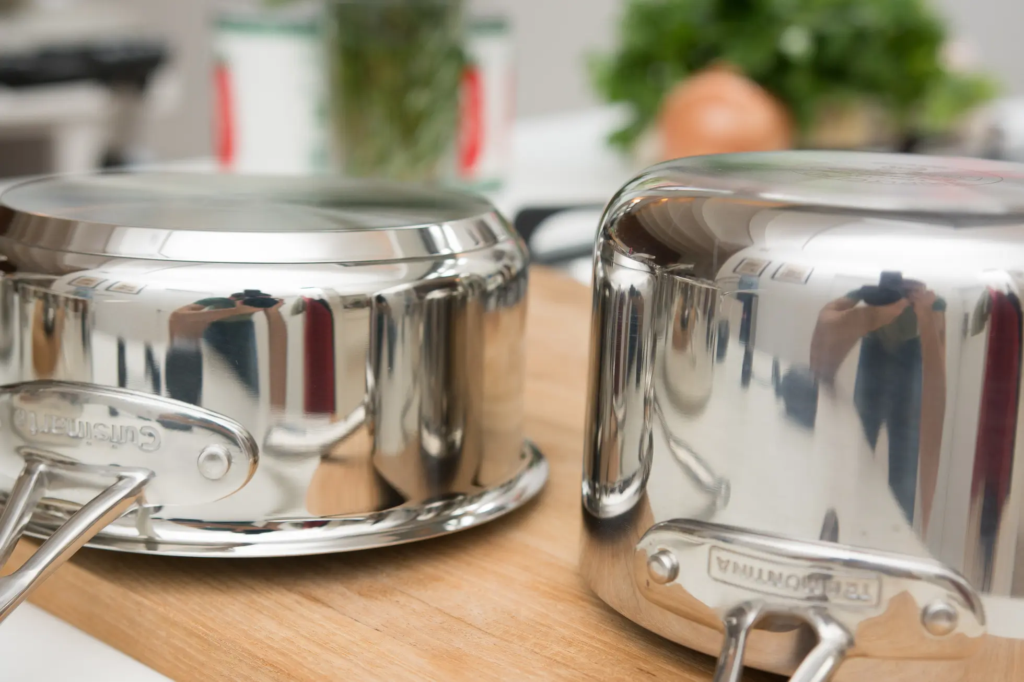
Features and accessories we avoided
- Glass lids: Glass lids can break or crack easily if dropped. They offer little advantage over stainless steel lids because you can’t see through them when they’re covered with condensation.
- Plastic handles: Even those made to withstand high temperatures can deteriorate over time.
- Five-ply cookware: Many manufacturers make expensive sets that are made from five or more layers of stainless steel, aluminum, and sometimes copper. In most of our tests, five-ply cookware took longer to heat up, didn’t heat as uniformly as tri-ply cookware, and was heavier. It also holds onto more heat and is slower to react when you lower the temperature on your stove.
- Sets that aren’t fully clad: If the aluminum core doesn’t extend up the sides of the cookware, it will be prone to scorching on the sides. Cookware with tri-ply disks welded to the bottom of the pan (also called encapsulated bottoms) distribute heat more evenly than pans made from a single piece of stainless steel, but we still wouldn’t recommend them for gas and electric stovetops. This type of cookware performs best on induction cooktops.
- Pasta insert or steamer baskets: These superfluous pieces take up too much space and/or have a shallow design that doesn’t allow enough circulation for pasta when boiling.
How we tested
For each set, we started by testing how well the large skillets retained heat. We did this by using an infrared thermometer to make a heat map of their cooking surface. We also dusted the surface of each large skillet with flour and placed the pan over a medium-high flame to see how evenly the flour browned. And we sautéed chicken pieces in the skillets to evaluate how uniformly the skin browned.
Using the large saucepan from each set, we prepared small batches of caramel to check for hot spots; then we simmered a large batch of tomato sauce in each stockpot to check for scorching. We also observed how easily we could pour liquids from each pot without dripping.
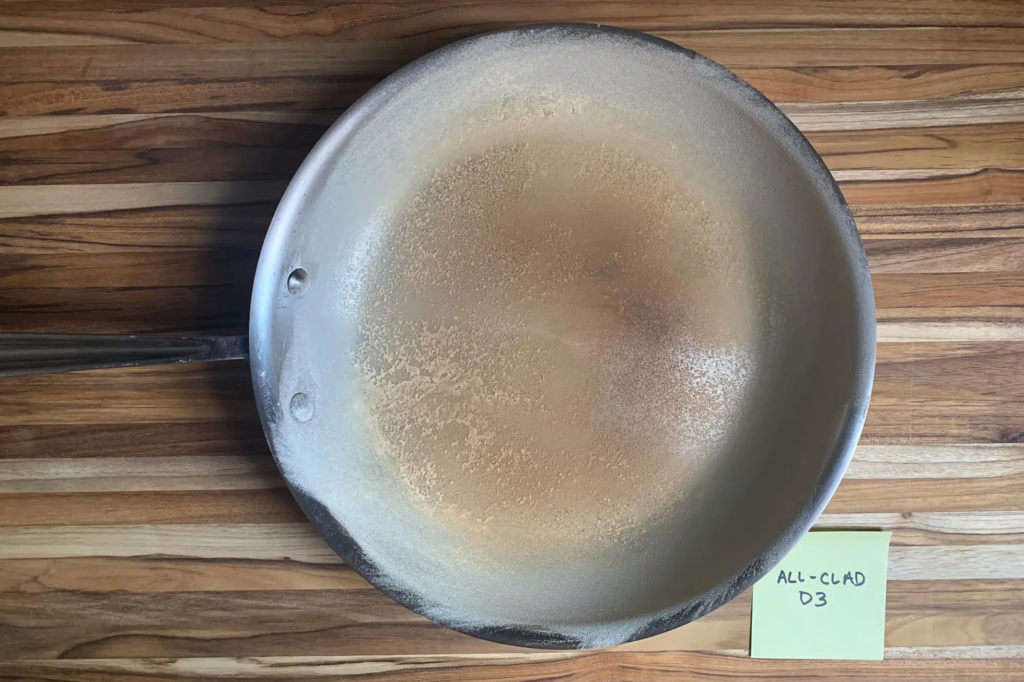
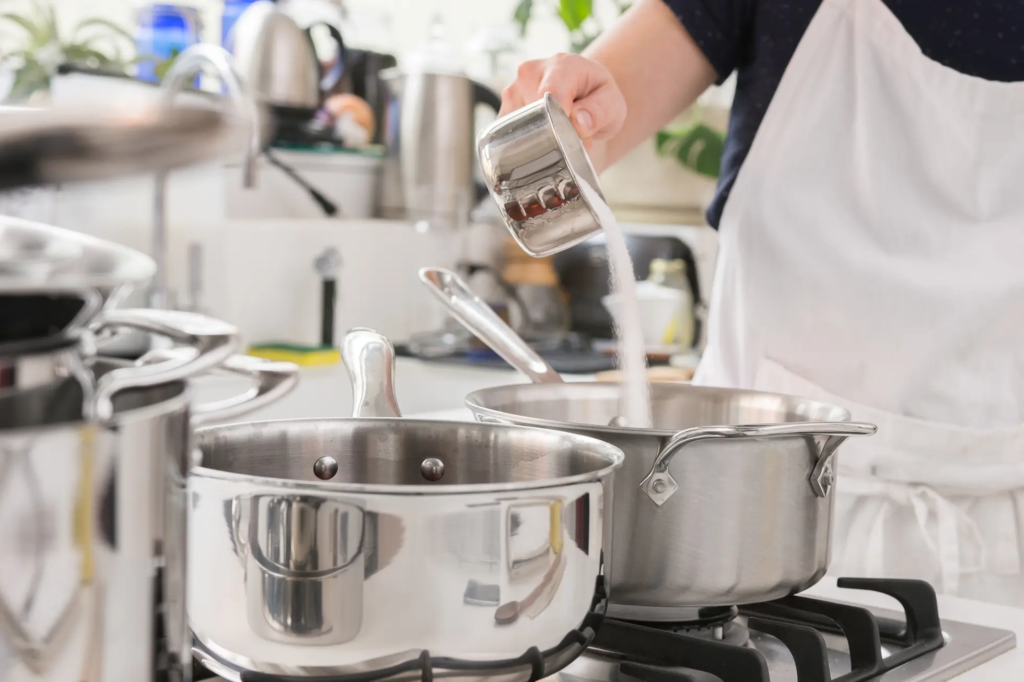
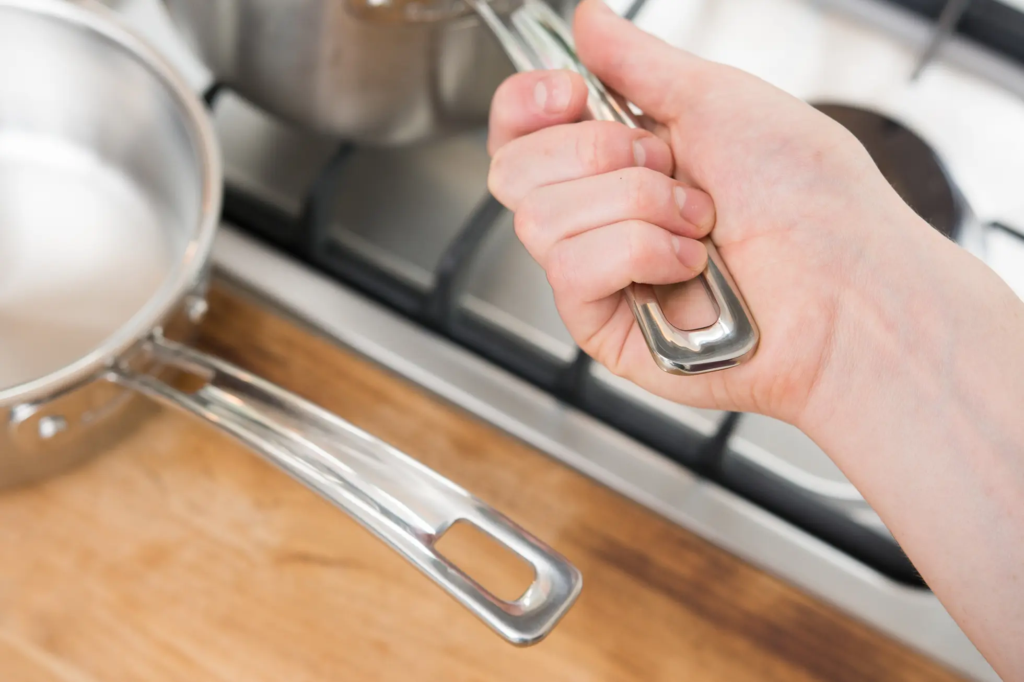
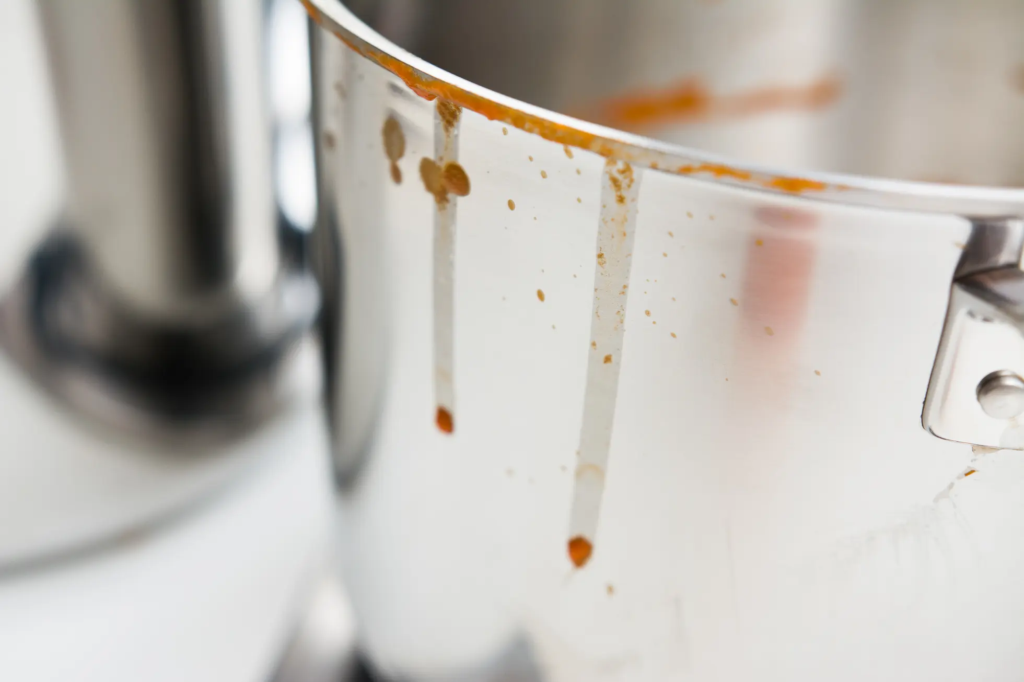
Additionally, we evaluated how easy the handles were to hold, especially when retrieving the pots and pans from a hot oven using a side towel or pot holders. We also took note of the individual weight and thickness of the pieces in each set.
By hand-washing the pots and pans, we got a sense of how easy they were to clean. And we looked at how well each set nested for convenient storage.
